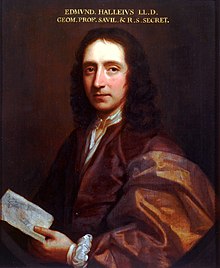Edmond Halley | |
|---|---|
 Portrait of Halley (c. 1690) | |
| Born | 8 November [O.S. 29 October] 1656 Haggerston, Middlesex, England |
| Died | 25 January 1742 [O.S. 14 January 1741] (aged 85) |
| Resting place | St. Margaret's, Lee, South London |
| Alma mater | The Queen's College, Oxford |
| Spouse |
Mary Tooke (m. 1682) |
| Children | 3[1] |
| Scientific career | |
| Fields | Astronomy, mathematics, physics, cartography |
| Institutions | University of Oxford Royal Observatory, Greenwich |

Edmond[2] (or Edmund)[3] Halley FRS (/ˈhæli/;[4][5] 8 November [O.S. 29 October] 1656 – 25 January 1742 [O.S. 14 January 1741])[6][7] was an English astronomer, mathematician and physicist. He was the second Astronomer Royal in Britain, succeeding John Flamsteed in 1720.
From an observatory he constructed on Saint Helena in 1676–77, Halley catalogued the southern celestial hemisphere and recorded a transit of Mercury across the Sun. He realised that a similar transit of Venus could be used to determine the distances between Earth, Venus, and the Sun. Upon his return to England, he was made a fellow of the Royal Society, and with the help of King Charles II, was granted a master's degree from Oxford.
Halley encouraged and helped fund the publication of Isaac Newton's influential Philosophiæ Naturalis Principia Mathematica (1687). From observations Halley made in September 1682, he used Newton's law of universal gravitation to compute the periodicity of Halley's Comet in his 1705 Synopsis of the Astronomy of Comets.[a] It was named after him upon its predicted return in 1758, which he did not live to see.
Beginning in 1698, Halley made sailing expeditions and made observations on the conditions of terrestrial magnetism. In 1718, he discovered the proper motion of the "fixed" stars.[8]
- ^ Cook, Alan (2012) [2004]. "Halley, Edmond". Oxford Dictionary of National Biography (online ed.). Oxford University Press. doi:10.1093/ref:odnb/12011. (Subscription or UK public library membership required.)
- ^ Cite error: The named reference
edmondwas invoked but never defined (see the help page). - ^ Hughes, David W.; Green, Daniel W. E. (January 2007). "Halley's First Name: Edmond or Edmund" (PDF). International Comet Quarterly. 29. Harvard University: 14. Bibcode:2007ICQ....29....7H.
Might we suggest... simply recogniz[ing] both forms, noting that—in the days when Halley lived—there was no rigid 'correct' spelling, and that this particular astronomer seemed to prefer the 'u' over the 'o' in his published works.
- ^ Jones, Daniel; Gimson, Alfred C. (1977) [1917]. Everyman's English Pronunciation Dictionary. Everyman's Reference Library (14 ed.). London: J. M. Dent & Sons. ISBN 0-460-03029-9.
- ^ Kenyon, John S.; Knott, Thomas A. (1953). A Pronouncing Dictionary of American English. Springfield, MA: Merriam-Webster Inc. ISBN 0-87779-047-7.
- ^ The source of the dates of birth and death is a biography of Edmond Halley written shortly after his death: Biographia Britannica, vol. 4, 1757, pp. 2494–2520. On his tombstone at Lee near Greenwich his year of birth and his year of death were inscribed as follows: Natus est A.C. MDCLVI. Mortuus est A.C. MDCCXLI. Before 1752 the Julian calendar was used in England. Also, the year began on 25 March.
- ^ "Halley, Edmond". astro.uni-bonn.de.
- ^ Gribbin & Gribbin (2017), p. 267.
Cite error: There are <ref group=lower-alpha> tags or {{efn}} templates on this page, but the references will not show without a {{reflist|group=lower-alpha}} template or {{notelist}} template (see the help page).